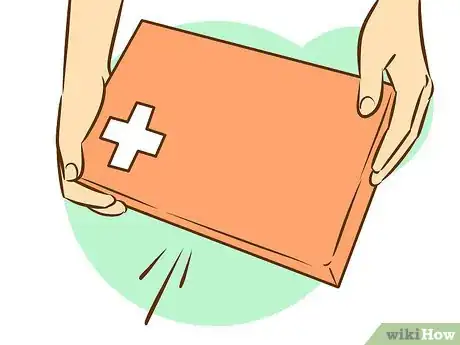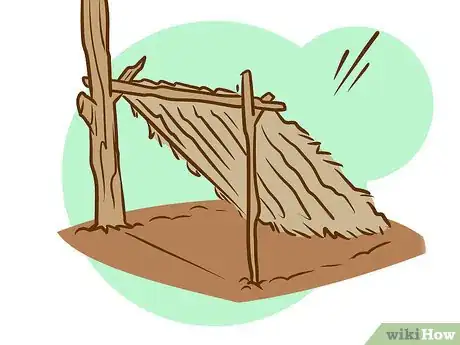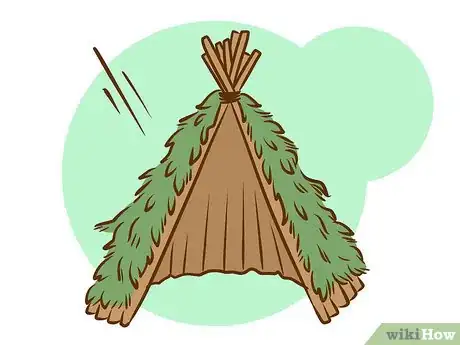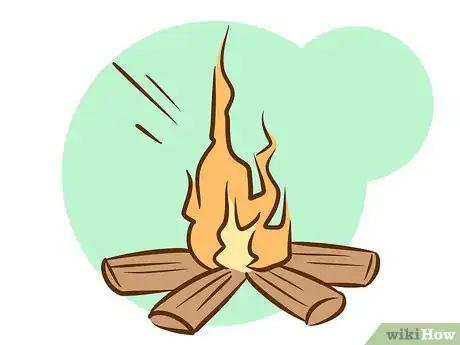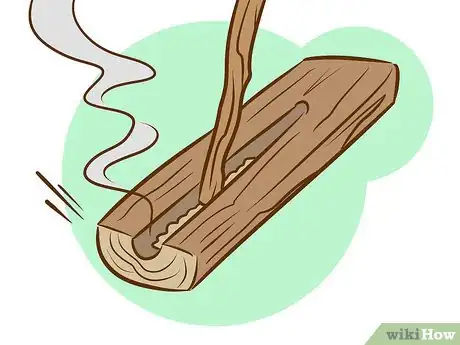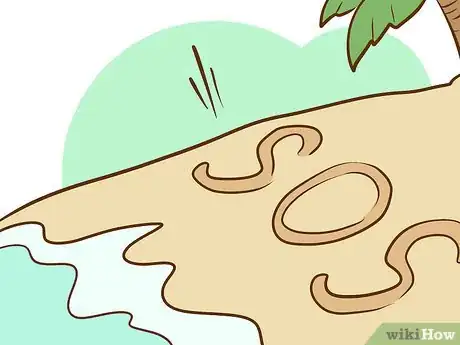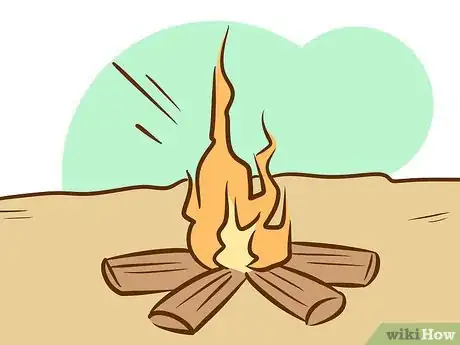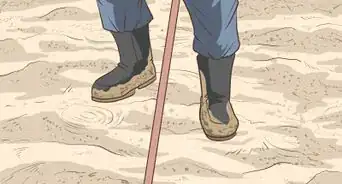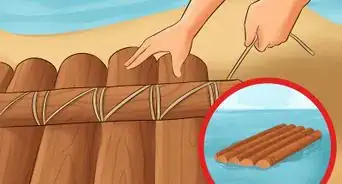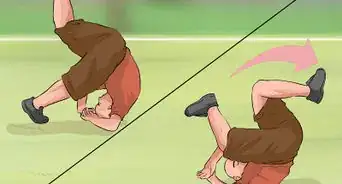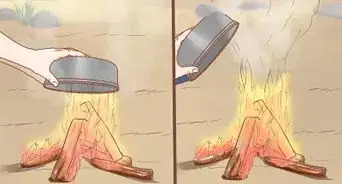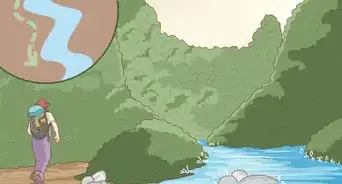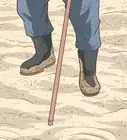wikiHow is a “wiki,” similar to Wikipedia, which means that many of our articles are co-written by multiple authors. To create this article, 30 people, some anonymous, worked to edit and improve it over time.
This article has been viewed 82,573 times.
Learn more...
The chances are extremely low, but one day you might just find yourself in the situation where you are stranded on a tropical island. If you are in a ship accident or plane crash, you might wash up on an isolated island. Your priorities should be to gather materials, find water and food, and make shelter and fire. Then you can can concentrate on getting rescued. This article addresses how to safely find water, food, shelter and fire as well as tips for being found.
Steps
Part I: Finding Food and Water
-
1Gather items that have washed up. Have a look around and see what else washed up with you. You might be able to find some supplies that could be used to help you.
- If you have a life raft, you can use the plastic from this to help you with water.
- If there is a first aid kit in the raft, you might need it if you get cut or sick.
- Any plastic containers, tubing, flashlights, mirrors, sharp objects etc. could come in handy.
- If there is a flare gun, save this and put it in a safe place. You might be able to use it if you see a passing ship or aircraft.
-
2Obtain fresh water. Finding a reliable source of fresh, drinkable water should be your first priority after you get your bearings and collect anything that washed up with you. Dehydration is your biggest danger when stranded.
- Venture inland to find a stream or pond.
- If you are stranded on a relatively large island, your likelihood of finding a freshwater stream or waterfall is more likely.
- If you can't find fresh water inland, you can collect rainwater.
- Collect rainwater in any containers you have or find from debris or washing up on the shore.
- You can also collect rainwater in large leaves and funnel it into a container.
Advertisement -
3Build a solar water still. If you can't find any suitable fresh water, collect enough rainwater, or you just want another backup source of water, you can build one of these to collect more fresh water. [1]
- You can build one of these if you have a container and plastic sheet.
- Dig a pit about 3 or 4 feet in diameter at a depth of 3 feet.
- At the center of the hole, dig a depression in the size and shape of a container you will collect water in.
- Place your container in the hole in the center.
- Place vegetation or leaves in the hole around the container. As the air heats in the hole, leaves or plants will help more moisture to collect.
- Drape a plastic sheet over the hole and anchor it down on the edges with rocks.
- Place a rock on the plastic in the center just above the container.
- Over the next few hours, moisture will build up in the pit from the heat and leaves. This will condense on the plastic and drip into the container.
- The water collected in the container will be safe to drink.
-
4Search for food. Don't venture too far into the jungle as you never know what is in there.
- You could look for fruits but make sure you recognize these fruits as edible ones.
- Your best bet for food will likely be fish that live in the shallow pools at the beach.
- The water should be shallow enough to walk through and look for fish.
- The best method of catching these is spear fishing. Create a spear from a long thin branch that is sharpened at one end.
- Stand on rocks when you spear fish to avoid disturbing the water and alarming the fish.
- Spear the fish quickly, aiming for the head. Try to spear fish that are still as you are more likely to hit them.
Part II: Making Shelter and Fire
-
1Try to find natural shelter. You need to find shelter for protection from the elements and predators.
- You don't know what lives on the island. Wild animals, especially predators, can pose a distinct threat.
- You will want to avoid the elements. Getting too wet isn't good even in warm conditions.
- It doesn't have to be fancy, just safe. Look for natural shelter such as rock outcroppings for temporary shelter until you can build a better structure.
-
2Build a lean-to shelter. This type of shelter consists of a large felled tree or branch braced against a large rock wall or standing tree.
- Find a large branch and brace it securely against a large tree.
- Place smaller branches at 45 degree angles along the larger branch.
- Drop leaves and foliage over the shelter to provide cover and additional protection from the elements.
- This can be a temporary shelter until you build a more secure tee-pee type of shelter.
-
3Build a tee-pee shelter. This is a more secure and permanent type of shelter which provides optimal protection from animals and the elements.
- Gather 10-20 long branches. The thicker these are, the stronger the structure will be.
- Stick 3 of the branches into the ground to create a tripod.
- Place the remaining branches in a circle around the tripod, leaving room for an entrance.
- Cover the structure with leaves, brush, and other foliage for protection.
-
4Start a fire as quickly as possible. You need to keep warm, even if it's warm during the day.
- It could get cold at night, so it is best to have a source of warmth.
- You will especially need a fire if you get wet from rain. It is important to stay as dry as possible.
- Also, the smoke might attract passing ships but keep it under control.
- Find tinder such as small dry twigs, grasses, and flammable debris. Arrange smaller twigs in a tripod with tinder underneath.
- Light the fire using a mirror, binoculars, or reflective surface by reflecting sunlight onto the dry kindling.
-
5Use the fire plow method to light a fire. For this method you will need a piece of soft wood, tinder, and a hard stick.
- Take the piece of soft wood and dig a groove into it with the stick.
- Place tinder on the end of the soft wood that you want to ignite.
- Using the hard stick, plow up and down the groove in the wood to create friction.
- When the tinder begins to ignite or smoke, blow on it to create bigger flames.
- Place small twigs on top of the ignited tinder to create a larger fire.
Part III:Trying to Get Rescued
-
1Try to contact others. If you have a mobile phone, see if you have any signal.
- Travel to higher ground to search for signal.
- If you manage to make a call, contact someone back home and tell them what happened and whereabouts you are.
- If you don't know where you are, look for landmarks on the horizon.
- If you can't find a cellphone signal, then explore the island carefully to see if there are any inhabitants with a radio or boat.
-
2Search the items you collected when you washed up. You might have bright plastic or a flare gun.
- Make flags from any bright colored material. These could be spotted during the day by a low flying aircraft.
- Keep the flare gun in a safe place that is quickly accessible. You will want to fire a flare if you see a passing ship or plane.
- You can also try to make reflected light signals with a large mirror if one washed up with you.
-
3Write messages in the sand. If there is a sandy area, make a giant SOS sign on the beach.
- Find large tree branches that you can arrange to spell SOS in the sand. This can be noticed by a passing airplane.
- You can also arrange large rocks in the same fashion.
- If you can't find enough material such as branches or rocks, you can write this message in the sand in big letters with a stick or even your hand.
- Keep in mind that you might have to fix this daily as the tide could wash parts of it away.
-
4Keep your fire going. The smoke and light could be noticed by passing aircraft or boats.
- Be careful your fire is not too big, as it could be potentially hazardous to you, your shelter, and wildlife.
- Keep your fire as close to shore as possible so smoke can be seen by passing ships.
- Try to keep it going throughout the night so aircraft can spot the flames from above.
Community Q&A
-
QuestionIf I don't have a plastic sheet, how can I make fresh water?
 Community Answerin theory, there are a gazillion procedures to do so, and they all depend on what you've got/what your surroundings are. On tropical islands there often is daily rain, so you could lay out split bamboo or anything else that can catch and hold rain. Unripe coconuts contain a juice that is not only tasty but also full of good nutrients. Some palm trees can also be "tapped" via inserting a straw or a small bamboo tube into the trunk.
Community Answerin theory, there are a gazillion procedures to do so, and they all depend on what you've got/what your surroundings are. On tropical islands there often is daily rain, so you could lay out split bamboo or anything else that can catch and hold rain. Unripe coconuts contain a juice that is not only tasty but also full of good nutrients. Some palm trees can also be "tapped" via inserting a straw or a small bamboo tube into the trunk. -
QuestionWhat type of food would someone find in a tropical forest?
 Community AnswerCoconuts. They are almost everywhere in the tropics. But it would be better to leave the forest behind and try to spear fish or forage for seafood.
Community AnswerCoconuts. They are almost everywhere in the tropics. But it would be better to leave the forest behind and try to spear fish or forage for seafood. -
QuestionHow do I keep my clothing warm?
 Community AnswerYou could make a table out of sticks over your fire, then put your clothing on the table for a couple minutes.
Community AnswerYou could make a table out of sticks over your fire, then put your clothing on the table for a couple minutes.
Warnings
- Keep your fire under control.⧼thumbs_response⧽
- Watch out for animals.⧼thumbs_response⧽
About This Article
To survive on a tropical island, start by gathering any items that may have washed ashore with you, such as first aid kits, buckets, food, or water. After you sift through any possible supplies, work on finding a source of food and water, such as streams or ponds, fruits, and fish. Additionally, try to find a natural shelter, or make one out of things like branches and leaves, in order to protect yourself from the elements. You'll also want to gather materials so you can build a fire for warmth or cooking. To learn how to get rescued, keep reading!
